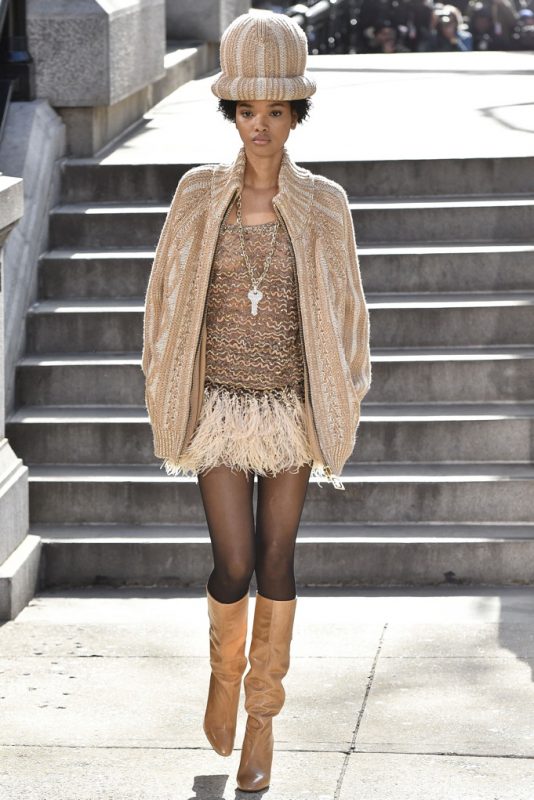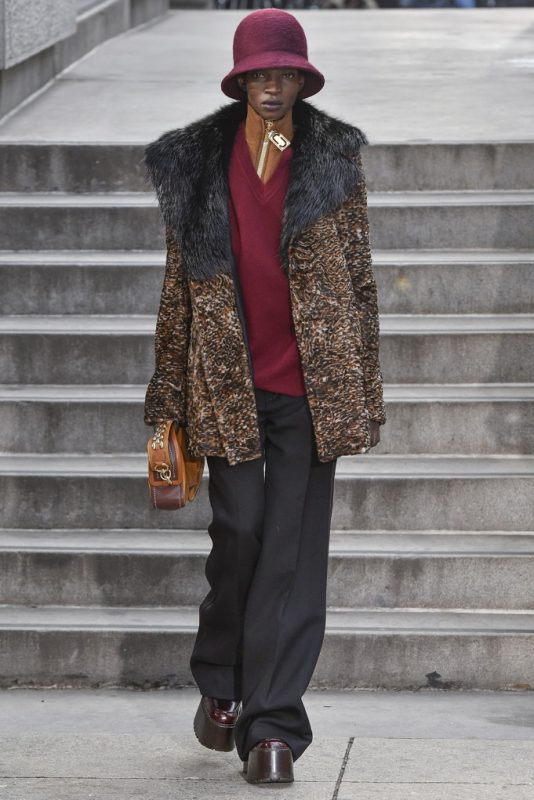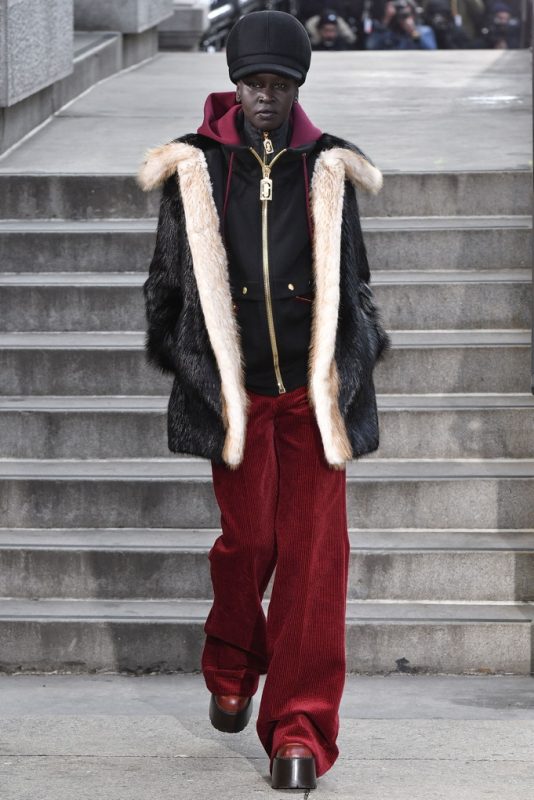Marc Jacobs turned the whole streetwear phenomenon on its head by taking it back to its origins this season. Jacobs referenced the late ‘70s and early ‘80s when hip-hop and street culture were just beginning to reach the mainstream. Jacobs was making a statement and so were the clothes, which included exaggerations of Rastafarian and Kangol hats, gold bling, major platforms, a huge selection of corduroy, and some killer track suits.
Jacobs is a reactionary in the best way. Challenge him and he will deliver. When he famously kept editors waiting for his show for over an hour one season, his reaction to complaints was to start the show the next season at the exact hour on the invitation much to many guests’ dismay. Last season, Jacobs was called out on social media for his use of dreadlocks to illustrate rave culture while casting very few models of color. His reaction? A show entirely dedicated to the origins of African American street culture and a tribute to its enormous influence on fashion today—complete with a very diverse casting. He went a step further with no set, no music, no interviews, and no iPhones permitted. One can’t help but feel this show was begging for music, but Jacobs wanted all eyes and ears firmly on the clothes and the message.
And this is why Marc Jacobs can firmly insist on being the single big show on the final Thursday of Fashion Week, because even for the international press and buyers, it’s quite simply worth the stay.
- Marc Jacobs New York Womenswear FW17 New York Feb 2017
- Marc Jacobs New York Womenswear FW17 New York Feb 2017
- Marc Jacobs New York Womenswear FW17 New York Feb 2017
- Marc Jacobs New York Womenswear FW17 New York Feb 2017
- Marc Jacobs New York Womenswear FW17 New York Feb 2017
- Marc Jacobs New York Womenswear FW17 New York Feb 2017
- Marc Jacobs New York Womenswear FW17 New York Feb 2017
- Marc Jacobs New York Womenswear FW17 New York Feb 2017
- Marc Jacobs New York Womenswear FW17 New York Feb 2017
- Marc Jacobs New York Womenswear FW17 New York Feb 2017
- Marc Jacobs New York Womenswear FW17 New York Feb 2017
- Marc Jacobs New York Womenswear FW17 New York Feb 2017
- Marc Jacobs New York Womenswear FW17 New York Feb 2017
- Marc Jacobs New York Womenswear FW17 New York Feb 2017
- Marc Jacobs New York Womenswear FW17 New York Feb 2017
- Marc Jacobs New York Womenswear FW17 New York Feb 2017
- Marc Jacobs New York Womenswear FW17 New York Feb 2017
- Marc Jacobs New York Womenswear FW17 New York Feb 2017
- Marc Jacobs New York Womenswear FW17 New York Feb 2017
- Marc Jacobs New York Womenswear FW17 New York Feb 2017
- Marc Jacobs New York Womenswear FW17 New York Feb 2017
- Marc Jacobs New York Womenswear FW17 New York Feb 2017
- Marc Jacobs New York Womenswear FW17 New York Feb 2017
- Marc Jacobs New York Womenswear FW17 New York Feb 2017
- Marc Jacobs New York Womenswear FW17 New York Feb 2017
- Marc Jacobs New York Womenswear FW17 New York Feb 2017
- Marc Jacobs New York Womenswear FW17 New York Feb 2017
- Marc Jacobs New York Womenswear FW17 New York Feb 2017
- Marc Jacobs New York Womenswear FW17 New York Feb 2017
- Marc Jacobs New York Womenswear FW17 New York Feb 2017
- Marc Jacobs New York Womenswear FW17 New York Feb 2017
- Marc Jacobs New York Womenswear FW17 New York Feb 2017
- Marc Jacobs New York Womenswear FW17 New York Feb 2017
- Marc Jacobs New York Womenswear FW17 New York Feb 2017
- Marc Jacobs New York Womenswear FW17 New York Feb 2017
- Marc Jacobs New York Womenswear FW17 New York Feb 2017
- Marc Jacobs New York Womenswear FW17 New York Feb 2017
- Marc Jacobs New York Womenswear FW17 New York Feb 2017
- Marc Jacobs New York Womenswear FW17 New York Feb 2017
- Marc Jacobs New York Womenswear FW17 New York Feb 2017
- Marc Jacobs New York Womenswear FW17 New York Feb 2017
- Marc Jacobs New York Womenswear FW17 New York Feb 2017
- Marc Jacobs New York Womenswear FW17 New York Feb 2017












































